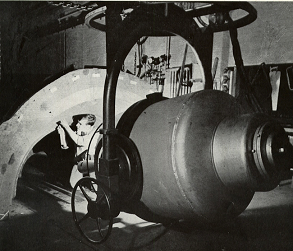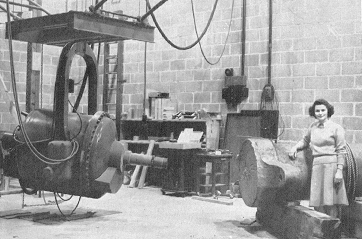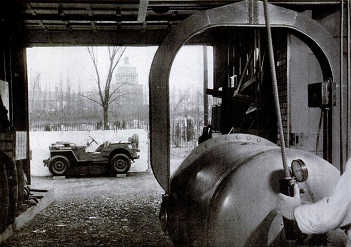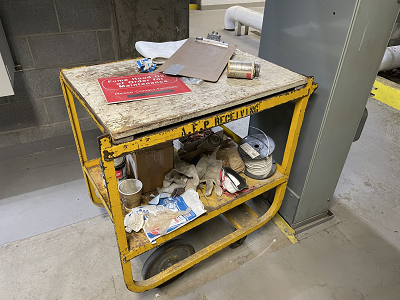

| Medical Center | Medical Center
Annex |
 |
 |
| Medical Center Annex in late 1943 after completion of 'B' Section
of building |
Medical Center Annex in 2010 |
 |
 |
 |
| Million Volt X-ray, Rochester Review 17(1) (December 1942-January 1943) | Million
Volt X-ray in 1945 |
X-ray of a jeep in 1946, from Life Magazine, March 25, 1946 Note Rush Rhees Library beyond cemetery in background. |
 |
| Medical Center Annex in
January 1951 |
 |
| Medical Center Annex in
December 1961. Note addition of third floor on the south
wing. |
A requirement that large military equipment be X-rayed led the University and several local companies to build a million volt X-ray machine that opened in January 1943 in a new building on the north side of Elmwood Avenue, next to the University's Central Utilities Plant. Dr. Stafford L. Warren, professor of radiology, headed up that project and in February 1943 he was recruited by General Leslie R. Groves to join the secret Manhattan Project that was developing atomic weapons.. An addition to the X-ray building (known as the 'B' section) was opened in September 1943 and another structure ('C') was added in early 1944. A third floor was added to the south wing during the 1950s..
The Manhattan Project was transferred to the new Atomic Energy Commission on January 1, 1947 and continued its work at the University, building a Cyclotron on River Campus in 1947 and the O Wing in 1950, which included a new tunnel under Elmwood Avenue to connect that building to the east end of the Annex building.
The buildings were later cleaned of radiation and transferred to the University, where now house laboratory and office space.
The building contained an animal crematorium that was shut down and its chimney was removed in October 2023.
One of the last remaining remnants of the Atomic Energy Program is this cart that is still used by facilities. It is not known if it glows in the dark.
 |
References
1942 "8
Firms, UR Erect Huge X-Ray Plant," Democrat and Chronicle,
December 17, 1942, Page 17. | Part
2 |
Project will spur industrial war effort.
The eight industries are financing the equipment and tho University will
supply scientific direction and laboratory staff. The project is being
handled for the University by Dr. Stafford L. Warren, professor of
radiology. The industrial concerns are Eastman Kodak Company, Consolidated
Machine Tool Corporation, Rochester Gas & Electric Corporation,
Pfaudler Company, Rochester Products Division of General Motors
Corporation, Delco Appliance Division of General Motors, Symington-Gould
Corporation and Rochester Brewing Company.
1943 "University and Eight Rochester Firms to Join in Million-Volt X-Ray Project," Rochester Review 17(1):5-6 (December 1942-January 1943)
1943 "X-Ray Machine for Castings Gets Million-Volt Tube," Democrat and Chronicle, January 12, 1943, Page 13.
1945 "Hidden Flaws in Huge Steel Castings Revealed by Million-Volt X-ray Tube," Rochester Review 23(3):7-8 (February-March 1945)
1945 The Rochester story [of the Manhattan project], by Andrew Hunter Dowdy.
1946 "X-ray Penetrates Door in Filming Jeep's Innards," Democrat and Chronicle, February 8, 1946, Page 17.
1946 "World's Biggest
X-Ray," Life Magazine, March 25, 1946. | 2021
blog including article | Picture of x-ray
machine and jeep, note Rush Rhees Library across the cemetery in the
background |
Huge machine records life-size image of jeep.
1950 The
First Quarter Century 1925-1950
Page 71: Department of Radiation Biology and Atomic Energy Project,
by Henry A. Blair
The west wing of the present Medical School Annex on the north side of
Elmwood Avenue had already been completed in January, 1943. It ·was built
to house million-volt x-ray equipment supplied by several Rochester
industries in order that they might have a facility to x-ray gun mounts
and other military supplies to ensure conformance with the government's
specifications. It was decided to erect the new Manhattan laboratory
contiguous to this building. Construction was begun early in June and
completed on September 1, 1943. This addition of the two-story red brick
south and east wings along with the one-story concrete-block structure
completed the "Annex" as it stands at present.
1956 Trial
balance; the education of an American, by Alan Valentine
Pages 144-160: Chapter 7. Men of Science.
Valentine's description of his first meeting with Major General Leslie R.
Groves and Colonel Kenneth D. Nichols.
1962 Now it can be told: the story of the Manhattan project, by Leslie R. Groves
1966 "The
Role of Radiology in the Development of the Atomic Bomb," by
Stafford L. Warren, in Radiology
in. World War II, edited by Kenneth D.A. Allen
Pages 848-849: Warren's description of his recruitment to the
Manhattan project by General Groves and Colonel Marshall.
1968 A
brief history of the University of Rochester Atomic Energy Project
from 1943-1968, by Henry Alexander Blair
Page 10: As mentioned above, the building occupied by the Department
on the north side of Elmwood Avenue is called the Medical School Annex, or
just the Annex. It now consists of three wings, A, B, and C. Wing A, 9700
sq. ft., was constructed in 1942 by the University to house high voltage
X-ray equipment for testing castings for the Armed Forces as previously
mentioned. Wing B, originally 15,000 sq. ft., and Wing C, originally
19,000 sq. ft., were built by the Manhattan District in 1943 and 1944.
Education space, O Wing, 53,000 sq. ft., was built by the Commission as an
addition to the Medical School in 1950. A tunnel under Elmwood Avenue
connects this building to the Annex. Additions to B Wing of the Annex have
been: the Alpha Laboratory , 6,000 sq. ft., in 1952; a third floor, 5,200
sq. ft., in 1961; and a low level counting facility, 600 sq. ft., in 1964.
In 1951 900 sq. ft. were added to C Wing for flash burn studies. A
radioactive storage vault, 200 sq. ft., was constructed off the tunnel
joining the Annex and the Medical School in 1961. All of these additions
were built by the Atomic Energy Commission. During 1965 and 1966 additions
to O Wing of the Medical School totaling 50,000 sq. ft. were constructed.
These consisted of an underground radiation facility off the tunnel and an
eight-story building, OO Wing, adjoining O Wing and containing
laboratories and lecture rooms
1975 To
each his farthest star: The University of Rochester Medical
Center -1925-1975, edited by Edward C. Atwater and John
Romano.
Page 280: Rochester first became involved in this medical program in
the middle of February 1943 when Dr. Albert K. Chapman, then vice
president and general manager of Eastman Kodak Co., invited Dr. Stafford
L. Warren, then professor of radiology at the Medical School, to luncheon
at the Rochester Club. At the luncheon Dr. Warren was introduced to
General Groves and Colonel Marshall, who queried him on his experience
with radiation and radioactive materials.
Following the luncheon, Dr. Chapman left, after advising Dr. Warren to do
whatever the officers requested. Then, according to Dr. Warren's account,
the officers took him to a private room where, after locking the door,
closing the transom, and examining a closet, they asked him if he would
consider working on a medical program of great importance to the
government but which involved the utmost secrecy.
Following consultation with President Valentine and Dean Whipple, on March
2, 1943 Dr. Warren accepted an appointment as civilian consultant to the
Manhattan District.
In April 1943 Dr. Warren and Major H. L. Friedell of the Manhattan
District planned an initial research program at Rochester.
On June 2, 1943, the present B Wing of what is now called the Annex was
started on the north side of Elmwood Avenue and was rushed to completion
by September 1943. This building, along with the adjoining, preexisting A
Wing of the Annex, which had been built the previous year by the Radiology
Department and equipped with a million-volt x-ray machine to examine
castings for the armed forces, provided a center for the new program.
Additional space was provided by other departments, notably biology,
physics, biochemistry, and radiology.
1977 History
of the University of Rochester, 1850-1962, by Arthur J.
May. Expanded edition with notes
Chapter 31: Women, Music and Medicine in Wartime
Easily the most exciting chapter--and the most closely guarded secret--in
the history of the School of Medicine involved the participation of staff
members in the so-called Manhattan Project that produced the first atomic
bombs. Back in 1939, American scientists had started researches pointed
toward the making of an atomic bomb; but progress was slow until taken in
hand by the National Defense Research Committee, known subsequently as the
Office of Scientific Research and Development of the War Department
(OSRD).
At mid-February of 1943, Dr. Albert K. Chapman, at the time vice-president
and general manager of the Eastman Kodak Company, invited Stafford L.
Warren; professor of radiology at the Medical School, to lunch where he
met Major-General Leslie R. Groves, chief officer of the Manhattan
District, U.S. Army Corps of Engineers. After Warren had been thoroughly
grilled on his experience with radiation and radioactive materials, he was
taken into a tightly-sealed room and asked whether he would undertake an
extremely important medical assignment requiring the utmost secrecy. He
consented. Groves next waited upon President Valentine and requested the
services of Warren for work very vaguely outlined. Valentine reluctantly
agreed to a leave of absence, reluctantly inasmuch as so many high-ranking
University scientists had already been "kidnapped" by the government; and
he pledged every possible University support for the enterprise. On March
2, 1943, Warren was named civilian consultant to the Manhattan District.
Warren was chosen primarily because he and Whipple had carried out
important pioneer investigations on the injurious effects of X-rays upon
dogs; succinctly stated, Warren was called upon to administer a laboratory
in which to study health hazards for workers engaged in atomic research.
Temporarily, space for research purposes was allocated in several sections
of the Medical Center, while essential facilities were being constructed
to the north of Elmwood Avenue. Called the Medical School Annex, the
structure consisted of three wings, one already in use for high-voltage
X-ray equipment, and ground for the other two units was broken on June 2,
1943. At the outset seven men comprised the research team, within three
months fifty were on the job, and seven times more by the time atomic
bombs were unloosed over Hiroshima and Nagasaki.
Experts from the Eastman Kodak Company and other Rochester firms took part
in the investigations, which required a wide diversity of training and
professional experience and a skillful coordination of a variety of
scientific techniques. When in November, 1943, Warren was summoned to
become medical director of the entire Manhattan Project with headquarters
at Oak Ridge, Tennessee, his first lieutenant, Andrew H. Dowdy, was put in
charge of the program at Rochester; major colleagues were William Bale, in
apparatus and instrumentation, Harold C. Hodge in toxicology, Joe W.
Howland in medical sciences, and Henry A. Blair in the biological effects
of radiation.
Among the problems posed to the University investigators were physical
examinations of personnel in nuclear energy plants exposed to occupational
hazards, methods of safeguarding workers engaged in atomic energy
production, such as the toxicity of radioactive materials, the biological
consequences of direct exposure to radiation, and the genetic effects of
ionizing radiation. For experiments about half a million mice were used,
some 200 monkeys, and other animals; consternation reigned (1944) after a
monkey escaped and indulged in monkeyshines for a fortnight until captured
at a football game, in readiness presumably to cheer for the University
eleven.
Tight security regulations prevailed. Guards refused admission to the
Annex to anyone without an official pass, workers engaged in a given piece
of research were prohibited from discussing it with others, and the
findings of the medical scientists were disclosed to only a few
high-placed individuals. After Japan capitulated, a modification in the
"enforced secrecy" permitted the University to reveal part of the part it
had played in the atomic bomb project, and high praise from Washington
accrued to the University for what had been accomplished. Thanks to the
Rochester scientists, not a single employee of the thousands involved in
making the A-bomb suffered injury by radiation or kindred phenomena. 17
Installed in the midst of the war, a powerful million volt X-ray machine,
mentioned above, was used for therapy and research and to test materials
for the military--heavy armor, aircraft parts, high pressure marine
valves, and so forth. Rochester firms paid for the building and equipment,
and in a single year thirty-five companies had recourse to the facility;
in fact, the demand grew so large that a second machine was set up.
1981 "The Manhattan Project: The U of R's Role," Democrat and Chronicle, February 15, 1981, Page 11.
1985 "Our Atomic Legacy," Democrat and Chronicle, August 4, 1985, Page 1. | Part 2 | Part 3 | Part 4 | Part 5 |
2020 Atomic Doctors: Conscience and Complicity at the Dawn of the Nuclear Age, by James L. Nolan
© 2021 Morris A. Pierce